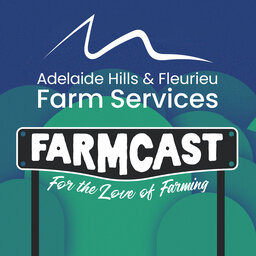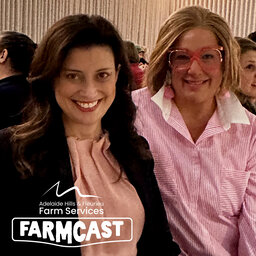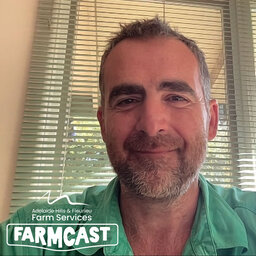Adelaide Hills Farmcast February 2023
Welcome to this month’s Adelaide Hills Farmcast or should I say Adelaide Hills and Fleurieu Farmcast!
In this episode of the Adelaide Hills and Fleurieu Farmcast, I go through our monthly almanac – a list of things to consider doing on your small acreage property and I talk with Paul Clifford from Raine and Horne Rural SA, based in Strathalbyn, about selling rural properties and what potential buyers are looking for.
Also, this episode rounds out our complete twelve months set of farm management tasks in our farm almanac. We’ve deliberately made them evergreen so that any July episode you listen to in any July will be relevant to that month. And they’ll be available forever.
But starting next month, we’ll take a broader look at farm operations and focus on one or two key things that small acreage farmers need to address as a part of running their farms throughout the year.
We have plenty of fodder to work through, but if you’d like to suggest a topic for us to discuss, please send us an email.
00:00 Adelaide Hills Farmcast February Edition
Introduction
01:00 Adelaide Hills Farm Almanac / Farm Calendar
Cattle
- February is stud bull selling season. The Stock Journal Beef Week 2023 this Friday the third with the Fleurieu, Adelaide Hills and Loxton cattle studs having their open day on Sunday 5th February.
- If you haven’t been to a beef field day, its well worth a look. Cattle studs are clustered into areas so that you can easily spend the day attending 4 – 5 different properties. Here in the Fleurieu, Adelaide Hills and Loxton we’ve got 11 enterprises opening their doors (or should I say gates) to the public. Some cattle studs offer the ability to buy cattle on the day, others use it as a prelude to their on-farm sales held at a later date. Of course, you will need a PIC number if you intend to make a purchase.
- And there won’t be just bulls on display. Many studs take the opportunity to display their breeding stock (cows and heifers) and sometimes there will be a pen of weaners there as well. Breeders generally take any opportunity they can to show what their cattle can achieve in the saleyards or abattoirs. The Stock Journal produce a guide to Beef Week so you can map out which properties are on display in your area.
All this talk of stud bulls and cattle sales may have you wondering what the difference is between stud cattle and commercial cattle?
Whilst I haven’t been able to find an Oxford Dictionary definition on what stud cattle are versus commercial cattle, I can explain it by saying that stud cattle are tightly held, lines of single breed cattle eg. Angus that are selected and bred with clear genetic advantages in mind. The cattle and their dams and sires will be registered with the breed association and this registration can be transferred to a person who purchases the cattle.
It’s like a family tree or ancestory. Stud cattle are generally sold with accompanying Estimated Breeding Values (or EBV’s) which are measurements of genetic potential that can be used to assess an animal’s breeding merit for a specific trait. For example birth weight (low birth weights are desirable as they represent calving ease however it may also indicate a later growth pattern), docility (quiet cattle are easier and safer to handle and tend to put more weight on more quickly. Interestingly, docility is a highly heritable trait like coat colour and so can be improved genetically with good breed selection), 400 Day Weight (the higher this figure is, the quicker you can potentially get a vealer to market) and Eye Muscle Area (the larger, more positive this is the more favourable as consumers will pay a premium for this cut of beef).
I have a tendancy to get a bit excited when I talk about EBV’s and it is tempting to get carried away with the data, but you must always look at the animal in front of you and take a visual assessment into account, together with the EBV’s when purchasing stud cattle.
Unlike stud cattle, commercial cattle are often a cross between two or more breeds for example Angus and Murray Grey Cross. This is done to improve the hybrid vigour with the goal of producing more weight per day of age. Commercial cattle rarely have EBV’s because other than average weight gains, few other traits are recorded. Stud cattle are generally considered genetically superior to commercial cattle and if being sold as stud cattle i.e. registration of that animal is transferred to the new owner, then that animal ‘should’ be a good representative of the breed with few visual or structural flaws.
If considering buying cattle for your property, its always a good idea to seek independent advice, stock agents are a good starting point and be prepared to pay more for stud cattle than commercial cattle.
If this is something you’d like more information on, you can go to futurebeef.com.au and navigate to the resources.
Spraying
- Pods is up at Summertown today putting the finishing touches on a fence around a house paddock, but I did ask him to give me a run down on the spraying jobs he’s got booked in for February.
- As soon as it rains, and the summer weeds have freshened up (which will help with the uptake of chemical), Pods is heading out to spray a few properties for cooch grass, potato weed, wire weed, cowtrop and melons. Particularly for the cooch grasses, he will be using a heavy brew of Glyphostate or Crucial 600, Garlon, LI-700 and Ammonium Sulphate.
- It will take a few goes to get rid of the cooch grass (we’ve got several applications planned for our back paddock throughout 2023), but the other weeds should only need one hit before the paddocks are ready to sow again.
Rabbits
- This is something I am not going to miss! I haven’t spotted a single rabbit on our property at Currency Creek and I’d really like to keep it that way!
- The Hills and Fleurieu landscape Board are running their rabbit baiting program again this month and we would encourage anyone with a rabbit problem to give it a go. (I’ve put a link to their registration page in the show notes). As we talked about last year in our April Edition of the Farmcast with Rob Murphy, you really need to attack rabbits on a number of fronts. One single method will not be enough to eradicate the problem.
Water
- This month, we’re replacing all the round plastic troughs on the property with more robust, cement troughs. I can acknowledge that plastic troughs have a place, but they really don’t hold up when you’ve got cattle drinking from them all the time.
- When we go to do this, I’ll take some footage and show you how we prepare the site with rubble so that its flat and slightly raised and how we install the float so that the trough is always kept full, but not overflowing.
Hay
- We are always talking about the importance of asking for a feed test when you’re purchasing hay.
- A few weeks ago with had Alice Morley from FP AG come out and take samples of the hay that we will have for sale. The results make interesting reading – protein levels are down because it was such a long wet season and there was such a delay in getting the hay cut and baled. But we’re not alone, most hay producers are in the same boat and at least when you buy our hay, you can determine for yourself if you want it for your horses, sheep, cattle etc.
- I took some footage of Alice taking samples, it’s a very easy process that only takes about 30 minutes. I’ll post it here soon, and in the socials.
08:54 Farmcast Interview: Paul Clifford from Raine and Horne Rural SA
The episode closes with my interview with Paul Clifford from Raine and Horne Rural SA.
In this chat I ask Paul about selling rural properties and what potential buyers are looking for.
He even helped me move some bales around our paddock!
 Adelaide Hills & Fleurieu Farmcast
Adelaide Hills & Fleurieu Farmcast


